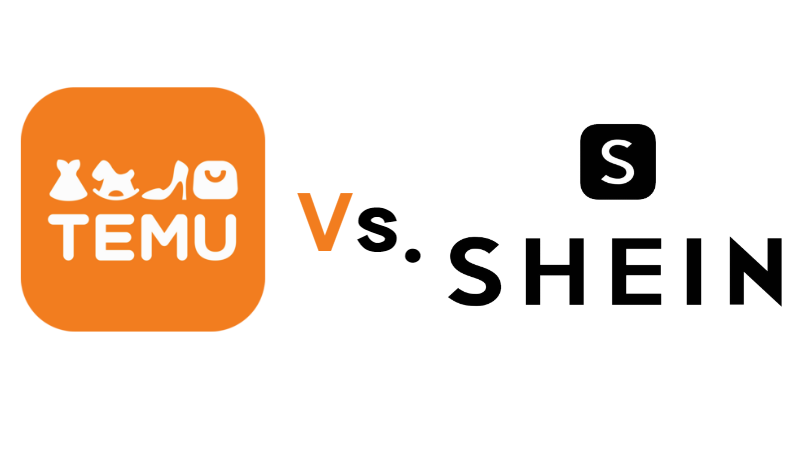Temu vs. Shein: Unraveling the Fabric of Online Fashion Giants

Introduction
In a world where fashion and convenience intersect, the digital age has given rise to online retail titans who are redefining the way we approach style.
Enter Temu and Shein, two platforms that are enveloped in the whirlwind of 'fast fashion', but which take distinctly varied paths to dress the aspirations of the modern consumer.
Temu, a newcomer to the scene, has quickly become a jack-of-all-trades in the retail space, providing an astonishing array of products that surpass the confines of wardrobe essentials.
Shein, in contrast, has carved its niche by rapidly translating runway trends into attainable apparel. As we thread the needle to contrast these two online fashion behemoths, it's imperative to understand that they are independent entities, each with their own narrative within the expansive e-commerce tapestry.
Temu and Shein's Business Models
Shein's dominance as a fast fashion retailer is underscored by its agility - swiftly capturing and offering the latest fashion trends with a business model that is fiercely pacey. Focused primarily on clothing, Shein has established a paradigm that ensures style-seekers are only a click away from the freshest designs without straining their wallets. This capability of fast trend translation appeals particularly to younger demographics who are not only fashion-forward but also hyper-aware of the changing tides in fashion.
Temu, on the other hand, seems to have taken a leaf from the books of colossal marketplace platforms. By offering an expansive range of products that include but are not limited to fashion, Temu presents itself as a general retail destination. Customers who come looking for a summer dress might find themselves leaving with a cordless drill in tow, a testament to the diversity in its catalog. This contrasts sharply with Shein's laser-like focus on attire and accessories, highlighting Temu's ambition to cater to a broader assortment of consumer needs.
Both players may share a stage in the e-commerce world, yet their performances are choreographed for markedly different audiences. As we explore these nuances, it becomes clear that while Shein dances to the rhythm of ever-evolving fashion, Temu orchestrates a symphony that plays to the tune of a comprehensive shopping experience.
Product Variety and Consumer Choices
In the digital storefronts where Temu and Shein vie for consumer attention, it's the spectrum of choice that sets the two apart. Shein's catalog brims with a vibrant array of clothing and accessories, aligning its offerings with the pulse of fashion's relentless evolution.
With thousands of new items ushered in regularly, Shein delivers a cornucopia of styles that reflect current trends, ensuring their consumer base always has access to fresh, trendy apparel.
Contrastingly, Temu has embraced a wider horizon beyond fashion's boundary. It operates as a vast online marketplace unfurling an assortment of product categories. Offering everything from voguish footwear to essential pet supplies, Temu caters to a more expansive set of consumer requirements. With its diverse range, Temu positions itself as a one-stop-shop, where shoppers can indulge in a holistic retail experience.
This distinct divergence in product diversity speaks to a broader strategy. Shein commits itself to be the mecca for fashion enthusiasts, while Temu offers a wider lens, bringing multiple product domains under one digital roof. This breadth of choice afforded by Temu suggests a different kind of engagement with the consumer—one that is based on the flexibility of choice and the convenience of fulfilling varied shopping needs in one transaction.
As the battle for online dominance continues, the diversity of offerings may just be a cornerstone for Temu's strategy to outpace its fashion-focused adversary, leading to an intriguing standoff in consumer preferences.
Market Presence and Social Media Influence
In the rapid ascension of Temu and Shein within the vast e-commerce arena, their prowess has been particularly highlighted by their deep-seated market presence and adept manipulation of social media channels.
Shein, having honed a keen marketing strategy, has charmed a global audience, proliferating its influence across the fashion domain. It's not just about the clothes but how Shein becomes an omnipresent force across social media platforms, impacting customer decisions through street-style influencers and splashes of visual content that appeals to the aesthetic senses of its audience.
As for the customer overlap with social media shoppers, Shein and Temu indeed share considerable common ground, especially on TikTok Shop, with Temu holding an impressive overlap. Shoppers mesmerized by the snappy videos and creative content on TikTok find themselves seamlessly transitioning from viewers to buyers, a testament to the platforms' competence in this digital marketing era. Temu has carved a substantial slice of the social media pie for itself by adopting a vigorous campaign on Meta platforms, signifying the importance of such visibility in today's market landscape.
Their savvy use of cyberspace, from user-generated content campaigns to targeted ads, has been nothing short of revolutionary. Both are creating more than just consumer bases but communities that are tightly woven into the social fabric—which could be just as influential as the products they sell. It's a digital tug-of-war between Temu's broad spectrum presence and Shein's fast-fashion focus, both vying for the top spot in the consumer's mind and across the web.
Quality and Customer Experience
When wading through the wave of online customer reviews, the sea of sentiments toward Temu and Shein is both vast and varied.
Feedback on Shein frequently touches on the delights of affordable pricing, though some waves of criticism crash over concerns of quality and the longevity of garments. These mixed reviews hint at a double-edged sword for Shein – affordability entices, yet durability questions linger.
Temu, while riding the crest of its rising popularity, also faces scrutiny. Shoppers, drawn by the allure of low prices and a wide selection, often find themselves questioning the resolve of their purchases as comments about size inconsistencies and one-time wears emerge. Temu's statement that affordable prices don't reflect lower quality standards reveals a dedication to maintaining stringent quality checks, addressing the pangs of price-quality correlation head-on.
The paradox of low prices and high expectations is, perhaps, the tightrope that both Temu and Shein tread. With promises of exceptional value, they must continuously juggle consumer desires for fashion that doesn't fray with the economic demands of their broad customer bases. As more shoppers turn to ecommerce for their fashion fixes, this balancing act casts a spotlight on the importance of credible customer service, and a transparent returns policy, which can make or break the trust shoppers place in online retail giants.
Business Strategies and Competitive Edges
The marketplace is a chessboard, and Temu and Shein are the grandmasters, each deploying their strategic moves with finesse. Shein has become synonymous with the fast fashion industry, pioneering an approach that turns catwalk designs into wardrobe staples at breakneck speeds. The brand's strategy centers around keeping the production lean, aligning closely with real-time fashion demand, and leveraging influencer marketing that magnifies its presence exponentially.
Temu has opted for a more all-encompassing strategy, casting a wide net over product offerings that traverse the gamut from fashion to household items. Coupled with a mobile-first design ethos, Temu ensures the user experience is seamless, fostering customer loyalty through a convenient and straightforward interface. Both platforms utilize gamification to capture the consumer's attention, with shopping experiences that are as engaging as they are rewarding.
These giants have also honed their ability to adjust business models dynamically, fully harnessing real-time data analytics to maximize sales and optimize margins. This data-driven approach allows them to stay at the forefront of ecommerce, ability maintaining a competitive edge over traditional retailers.
In the grand scheme of the e-commerce world, it's these strategic nuances that set Temu and Shein apart. By understanding consumer behavior and adapting to the digital landscape, they have not only risen to the challenge but also redefined retail for the digital age.
Aligning with Specific Demographics
A laser-focus on specific demographics greatly props up the success of online retail behemoths like Temu and Shein. Each employs sophisticated strategies to charm key segments of the consumer market, with Shein, in particular, striking a chord with millennials and Gen Z shoppers. Their catalog of affordable, on-trend clothing and easy-access mobile platform speaks directly to a young audience that craves style at the speed of social media.
Temu's approach is equally calculated. By offering a diverse selection that spans multiple categories, they appeal to a broad demographic, though they've found significant traction with the same younger audiences that frequent platforms like TikTok. Both companies are acutely aware of the importance of this demographic; these shoppers not only demand the latest trends but also dictate them, engaging in the viral nature of today's fashion landscape.
Influencer marketing is a key component in reaching these consumers. Shein has masterfully orchestrated a network of micro-influencers, offering incentives like free clothes in exchange for exposure to numerous niche audiences. This grassroots-style campaign has been instrumental in broadening its reach and establishing brand loyalty among its targeted demographics.
Each brand's alignment with its respective consumer base is not arbitrary, but a result of meticulously crafted strategies designed to resonate with the desires and behaviors of these critical shopper segments. As such, Temu and Shein continue to adjust and advance their methods to maintain affinity with their customers, understanding that success in this arena is as much about knowing who to sell to as it is about what to sell.
The Future Trajectory of Temu and Shein in E-commerce
As we fasten the last button on this comparative analysis of Temu and Shein, the big question remains: what does the future hold for these e-commerce giants within the digital bazaar? The trajectory for both appears promising yet laden with the necessity for adaptation and finesse.
Shein's position in the fast fashion industry seems resilient, bolstered by a formula that has successfully captivated a global audience. However, staying on top will require the brand to pivot with the winds of sustainable fashion and ethical consumerism. Meanwhile, the future for Temu looks auspicious as it rises to meet the demands of a demographic that craves not just fashion but a comprehensive lifestyle destination online.
The shared path for both is clear: sustaining momentum hinges on innovating customer experience, refining supply chain efficiency, and embracing the growing call for ethical practices. It's a continual evolution, where listening to the heartbeat of consumer needs complements the hard data driving business decisions.
Whether they will continue to ride the high tide of e-commerce success or face the headwinds of shifting consumer tides and market saturation is an unfolding story. However, one element is certain: the digital marketplace will remain a vibrant arena for the foreseeable future, with Temu and Shein as significant players shaping its narrative.

